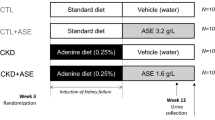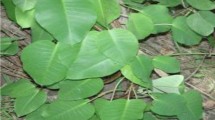Abstract
The present study aims to investigate the heptonephro-protective effect of grape seeds proanthocyanidin extract (GSPE) against the risks induced by gibberellic acid (GA3) in male rats. The results recorded that GA3 caused a significant increase in total lipids, total cholesterol, triglycerides and LDL-C levels in serum, concomitant with a significant decrease in serum HDL-C. A significant increase in serum AST, ALT, urea and creatinine, while, a significant decrease in total protein content in serum was observed in rats given GA3. Hepatic and renal lipid peroxidation product (MDA) was significantly increased, meanwhile, total antioxidant capacity (TAC), glutathione, and catalase levels were significantly decreased. In addition, there was a negative change in liver structure including dilatation in the central veins with degeneration of endothelium cells and cellular injury around the veins as well as in the kidney structure such as lesion in both glomeruli and tubules, detachment of the Malpighian corpuscles from the Bowman’s capsule’s epithelium, shrinkage in the glomerular capillary network. However, almost all of these adverse effects seemed to be ameliorated by oral administration of GSPE with GA3 to rats for 2 month indicating the protective effect of grape seeds GSPE on GA3 induced oxidative stress in rats.


Similar content being viewed by others
References
Arous S, Boussaid M, Marrakchi M (2001) Plant regeneration from zygotic embryo hypocotyls of Tunisian chilli (Capsicum annuum L.). J Appl Hortic 3:17–22
Ashikari M, Sakakibara H, Lin S, Takashi T, Nishimura T, Angeles A, Qian ER, Matsuoka H (2005) Cytokinin oxidase regulates rice grain production. Science 309:741–745
Bagchi D, Bagchi M, Stohs SJ, Das DK, Ray SD, Kuszynski CA, Joshi SS, Pruess HG (2000) Free radicals and grape seed proanthocyanidin extract: importance in human health and disease prevention. Toxicology 148:187–197
Bagchi D, Bagchi M, Stohs SJ, Ray SD, Sen CK, Pruess HG (2002) Cellular protection with proanthocyanidins derived from grape seeds. Ann New York Acad Sci 957:260–270
Bhalla P, Dhawan DK (2009) Protective role of lithium in ameliorating the aluminium induced oxidative stress and histological changes in rat brain. Cell Mol Neurobiol 29:513–521
Blade C, Arola L, Salvado MJ (2010) Hypolipidemic effects of proanthocyanidins and their underlying biochemical and molecular mechanisms. Mol Nutr Food Res 54:37–59
Bock PP, Karmer R, Paverka M (1980) A simple assay for catalase determination. Cell Biol Monogr 7:44–74
Celik I, Ozbek H, Tuluce Y (2002) Effects of subchronic treatment of some plant growth regulators on serum enzyme levels in rats. Trends J Biol 26:73–76
Celik I, Turker M, Tuluce Y (2007) Abcisic acid and gibberellic acid cause increased lipid peroxidation and fluctuated antioxidant defense systems of various tissues in rats. J Hazard Mater 148:623–629
Cetin A, Kaynar L, Kocyigit I, Hacioglu SK, Saraymen R, Ozturk A, Orhan O, Sagdic O (2008) The effect of grape seed extract on radiation induced oxidative stress in the rat liver. Turk J Gastroenterol 19:92–98
Craig W, Beck L (1999) Phytochemicals: health protective effects. Can J Diet Pract Res 60:78–84
De Melo MP, Pithon-Curi TC, Miyasaka CK, Palanch AC, Curi R (1998) Effect of indole acetic acid on oxygen metabolism in cultured rat neutrophil. General Pharm 31:573–578
Dimitrova MST, Tsinova V, Velcheva V (1994) Combined effect of zinc and lead on the hepatic superoxide dismutase-catalase system in carp (Cyprinus carpio). Comp Biochem Physiol 108:43–46
Friedewald WT, Levy RI, Fredrickson DS (1972) Estimation of the concentration of low density lipoprotein cholesterol in plasma, without use of the preparative ultracentrifuge. Clin Chem 18:499–502
Frings CS, Fendley TW, Dunn RT, Queen CA (1972) Improved determination of total serum lipids by the sulfo-phospho-vanillin reaction. Clin Chem 18:673–674
Ghadir MR, Riahin AA, Havaspour A, Nooranipour M, Habibinejad AA (2010) The relationship between lipid profile and severity of liver damage in cirrhotic patients. Hepat Mon 10:285–288
Halsted CH (2004) Nutrition and alcoholic liver disease. Semin Liver Dis 24:289–304
Henry RJ (1964) Determination of total protein by colorimetric method. Clin. Chem. Harper and Row publishers, New York, p 181
Herken H, Uz E, Ozyurt H, Sogut S, Virit O, Akyol O (2001) Evidence that the activities of erythrocyte free radical scavenging enzymes and the products of lipid peroxidation are increased in different forms of schizoprenia. Mol Psychiatry 6:66–73
Ishige K, Schubert D, Sagara Y (2001) Flavonoids protect neuronal cells from oxidative stress by three distinct mechanisms. Free Radic Biol Med 30:433–446
Jiao Z, Liu J, Wang S (2005) Antioxidant activities of total pigment extract from blackberries. Food Technol Biotechnol 43:97–102
Joshi SS, Kuszyński CA, Bagchi D (2001) The cellular and molecular basis of health benefits of grape seed proanthocyanidin extract. Current Pharmacol Biotechnol 84:187–194
Kanner J, Frankel E, Grant R, German B, Kinsella E (1994) Natural antioxidants in grape and wines. J Agric Food Chem 42:64–69
Karthikeyan K, Sarala Bai BR, Niranjali Devaraj S (2007) Cardioprotective effect of grape seed proanthocyanidins on isoproterenol induced myocardial injury in rats. Int J Cardiol 115:326–333
Koracevic D, Koracevic G, Djordjevic V, Andrejevic S, Cosic V (2001) Method for the measurement of antioxidant activity in human fluids. J Clin Pathol 54:356–361
Martinez-Florez S, Gonzalez-Gallego J, Culebras JM (2002) Flavonoids: properties and antioxidizing action. Nutr Hosp 17:271–278
Muthuraman P, Ravikumar S, Vikramathithan J, Nirmalkumar G, Srikumar K (2010) Effect of phytohormones on tissue hexokinase and on some blood components in wistar rats. Int J Drug Delivery 2:168–172
Ohkawa H, Wakatsuki A, Kaneda C (1982) Assay for lipid peroxides in animal tissues by thiobarbaturic acid reaction. Anal Biochem 95:351–358
Prins HK, Loose JA, (1969) Glutathione. Chapter 4. Biochemical Methods in Red Cell Genetics. Edited Academic press. N.Y.D. London, p 126–129
Regoli F, Principato G (1995) Glutathione, glutathione dependent and antioxidant enzymes in mussel, Mytilus galloprovincialis, exposed to metals under field and laboratory conditions: implications for the use of biochemical biomarkers. Aquat Toxicol 31:143–164
Reitman S, Frankel S (1957) Colorimetric estimation of serum transaminases. Am J Clin Path 28:56–63
Rodwell EW (1979) In: A review of physiological chemistery (Harper HA, Rodwell EW, Mayes P (Eds), 17th edn, Lange Medical Publications, California pp 401–404
Sakr S, Okdah Y, El-Abd S (2003) Gibberellin A3 induced histological and histochemical alterations in the liver of Albino rats. Sci Asia 29:327–331
Salisbury FB, Ross CW (2009) General and applied plant physiology. 35: 146–152
Sarandol E, Ta S, Dirican M, Serdar Z (2005) Oxidative stress and serum paraoxonase activity in experimental hypothyroidism: effect of vitamin E supplementation. Cell Biochem Funct 23:1–8
Sehirli O, Ozel Y, Dulundu E (2008) Grape seed extract treatment reduces hepatic ischemia reperfusion injury in rats. Phytother Res 22:43–48
Serrano J, Puupponen-Pimia R, Dauer A, Aura AM, Saura-Calixto F (2009) Tannins: current knowledge of food sources, intake, bioavailability and biological effects. Mol Nutr Food Res 53:310–329
Shan Y, Ye X, Xin H (2010) Effect of the grape seed proanthocyanidin extract on the free radical and energy metabolism indicators during the movement. Sci Res Essay 5:148–153
Shin MO, Yoon S, Moon JO (2010) The proanthocyanidins inhibit dimethylnitrosamine induced liver damage in rats. Arch Pharm Res 33:167–173
Silverstone AL, Sun T (2000) Gibberellins and the green revolution. Trends Plant Sci 5:1–2
Snedecor GW, Cochran WG (1982) Statistical Methods, 7th edn. The State University Press American, Iowa, p 593
Soliman HAE, Mantawy MM, Hassan HM (2010) Biochemical and molecular profiles of gibberellic acid exposed albino rats. J Am Sci 6:224–229
Spranger I, Sun B, Mateus AM, Freitas V, Ricardo-da-Silva JM (2008) Chemical characterization and antioxidant activities of oligomeric and polymeric procyanidin fractions from grape seeds. Food Chem 108:519–532
Srikumar K, Vikramathithan J, Gautami G, Ganesh I (2009) Differences in rat tissue lactate dehydrogenase activity caused by giberellic acid and homobrassinolide. Turk J Biochem 34:57–61
Studenik P (2000) Lipid disorders in liver diseases. Vnitr Lek 46:547–548
Sun BS, Belchior GP, Ricardo-da-Silva JM, Spranger MI (1999) Isolation and purification of dimeric and trimeric procyanidins from grape seeds. J Chromato A 841:115–121
Terra X, Valls J, Vitrac X, Mérrillon JM, Arola L, Ardèvol A, Bladé C, Fernandez-Larrea J, Pujadas G, Salvadó J, Blay M (2007) Grape-seed procyanidins act as antiinflammatory agents in endotoxin-stimulated RAW 264.7 macrophages by inhibiting NFkB signaling pathway. J Agric Food Chem 55:4357–4365
Troudi A, Samet AM, Zeghal N (2009) Hepatotoxicity induced by gibberellic acid in adult rats and their progeny. Exp Toxicol Pathol 62:637–642
Troudi A, Bouaziz H, Soudani N, Amara IB, Boudawara T, Touzani H, Lyoussi B, Zeghal N (2011) Neurotoxicity and oxidative stress induced by gibberellic acid in rats during late pregnancy and early postnatal periods: biochemical and histological changes. Exper Toxico Pathol 37:429–438
Tuluce Y, Celik I (2006) Influence of subacute and subchronic treatment of abcisic acid and gibberellic acid on serum marker enzymes and erythrocyte and tissue antioxidant defense systems and lipid peroxidation in rats. Pest Biochem Physiol 86:85–92
Wang J, Ho L, Zhao W, Ono K, Rosensweig C, Chen L, Humala NB, Teplow DM, Pasinetti G (2008) Grape derived polyphenolics prevent Aβ oligomerization and attenuate cognitive deterioration in a mouse model of Alzheimer’s disease. J Neurosci 28:6388–6392
Wren AF, Cleary M, Frantz C, Melton S, Norris L (2002) 90-day oral toxicity study of a grape seed extract (IH636) in rats. J Agric Food Chem 50:2180–2192
Yamakoshi J, Kataoka S, Koga T, Ariga T (1999) Proanthocyanidin rich extract from grape seeds attenuates the development of aortic atherosclerosis in cholesterol-fed rabbits. Atherosclerosis 142:139–149
Young DS (1995) Effects of Drugs on Clinical Laboratory Tests, 4th Ed. AACC Press, Washington, DC, pp 4–57
Yousef MI, El-Demerdash FM, Kamel KI, Al-Salhen KS (2003) Changes in some hematological and biochemical indices of rabbits induced by isoflavones and cypermethrin. Toxicology 189:223–234
Yousef MI, Saad AA, El-Shennawy LK (2009) Protective effect of grape seed proanthocyanidin extract against oxidative stress induced by cisplatin in rats. Food Chem Toxicol 47:1176–1183
Yu F, Wang Z, Ju B, Wang Y, Wang J, Bai D (2008) Apoptotic effect of organophosphorus insecticide chlorpyrifos on mouse retina in vivo via oxidative stress and protection of combination of vitamin C and E. Exp Toxicol Pathol 59:415–423
Acknowledgments
The authors of this manuscript express their deepest gratitude and appreciation to Prof. Dr Mosaad A. Abdel-Wahhab, Food Toxicology & Contaminants Department, National Research Center, Dokki, Cairo, Egypt for his financial assistance, sincer guidance in revision of this work with kindly directions.
Author information
Authors and Affiliations
Corresponding author
Rights and permissions
About this article
Cite this article
Hassan, H.A., Al-Rawi, M.M. Grape seeds proanthocyanidin extract as a hepatic-reno-protective agent against gibberellic acid induced oxidative stress and cellular alterations. Cytotechnology 65, 567–576 (2013). https://doi.org/10.1007/s10616-012-9506-6
Received:
Accepted:
Published:
Issue Date:
DOI: https://doi.org/10.1007/s10616-012-9506-6




